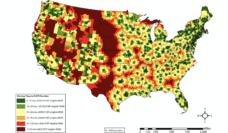The United States is facing a spike in sexually transmitted infections (STIs). The Centers for Disease Control and Prevention recently reported 2.4 million combined cases of the three most commonly reported STIs across the nation in 2018. When left untreated, syphilis, gonorrhea, and chlamydia, are associated with pelvic inflammatory disease, ectopic pregnancy, greater HIV risk, infertility, and other long-term health problems.
Reported cases of chlamydia increased to more than 1.7 million last year, the most ever reported in the US. Gonorrhea increased 5% to over 580,000 cases, and primary and secondary syphilis cases increased 14% to over 35,000 cases, the highest numbers reported since 1991. Cases of syphilis passed from mothers to their babies during pregnancy resulted in a 22% escalation in newborn deaths between 2017 and 2018. As alarming as these numbers are, they’re likely underestimates because many STIs go undiagnosed.
What’s driving this dramatic rise? According to researchers, substance use, unstable housing, and reduced condom use among young people and men who have sex with men are part of the problem. Cuts to state and local health promotion programs and clinic closures are also to blame as they have resulted in less screening and decreased linkage to healthcare services.
So, what can be done? Syphilis, gonorrhea, and chlamydia can be cured by antibiotics. Although medication can stop the infection, it won’t reverse the most serious long-term effects. Preventing these infections using condoms and/or dental dams during sexual activity is critical. Because these infections can present few or delayed symptoms, it’s also important to get tested regularly.
Databyte via Niall McCarthy, “U.S. STD Cases Rise to Record High,” Statista, October 10, 2019.














